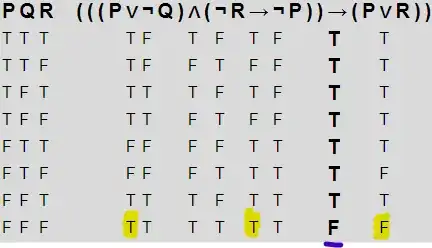The Logic Problem, taken from WFF’N PROOF, The Game of Logic, has these two assumptions:
- “Logic is difficult or not many students like logic.”
- “If mathematics is easy, then logic is not difficult.”
By translating these assumptions into statements involving propositional variables and logical connectives, determine whether each of the following are valid conclusions of these assumptions:
- a) That mathematics is not easy, if many students like logic.
- b) That not many students like logic, if mathematics is not easy.
- c) That mathematics is not easy or logic is difficult.
- d) That logic is not difficult or mathematics is not easy.
- e) That if not many students like logic, then either mathematics is not easy or logic is not difficult.
Here's my solution (in detail). I'm not sure if I did all this correctly. I just want to make sure if I made any mistake!
$D(x):$ "$x$ is difficult"
$S(x):$ "Many students like $x$"
$l$ and $m$ to represent logic and mathematics.
Assumptions:
- $D(l) \lor \lnot S(l)$
- $\lnot D(m) \to \lnot D(l)$
Conclusions:
- a) $\; S(l) \to D(m) $
- b) $\; D(m) \to \lnot S(l) $
- c) $\; D(l) \lor D(m) $
- d) $\; \lnot D(l) \lor D(m) $
- e) $\; \lnot S(l) \to (D(m) \lor \lnot D(l)) $
I'm quite sure that the first conclusion (a) is valid.
$ 1) D(l) \lor \lnot S(l) $ : Assumption 1
$ 2) S(l) \to D(l) $ : Logical equivalence of (1)
$ 3) \lnot D(m) \to \lnot D(l) $ : Assumption 2
$ 4) D(l) \to D(m) $ : Contrapositive of (3)
$ 5) S(l) \to D(m) $ : Hypothetical syllogism on (2) and (4)
The second conclusion (b) is invalid because since the conclusion (a) is valid and this conclusion is $ D(m) \to \lnot S(l) \equiv S(l) \to \lnot D(m) \not\equiv S(l) \to D(m) $
The third conclusion (c) is invalid because the assumption (2) is not equivalent to this conclusion: $ \lnot D(m) \to \lnot D(l) \equiv \lnot D(l) \lor D(m) \not\equiv D(l) \lor D(m) $
The fourth conclusion (d) is valid because the assumption (2) is equivalent to this conclusion$ \lnot D(m) \to \lnot D(l) \equiv \lnot D(l) \lor D(m) $
The last conclusion (e) is invalid followingly according to the rules of inference:
$ 1) D(l) \lor \lnot S(l) $ :Assumption 1
$ 2) \lnot D(m) \to \lnot D(l) \equiv \lnot D(l) \lor D(m) \equiv \lnot D(l) \lor (\lnot D(l) \lor D(m)) $
$ 3) \lnot S(l) \lor (\lnot D(l) \lor D(m)) $ : Resolution rule on (1) and (2)
$ 4) S(l) \to (\lnot D(l) \lor D(m)) $ : Logical equivalence of (3)
$ 5) S(l) \to (\lnot D(l) \lor D(m)) \not\equiv \lnot S(l) \to (\lnot D(l) \lor D(m)) $
